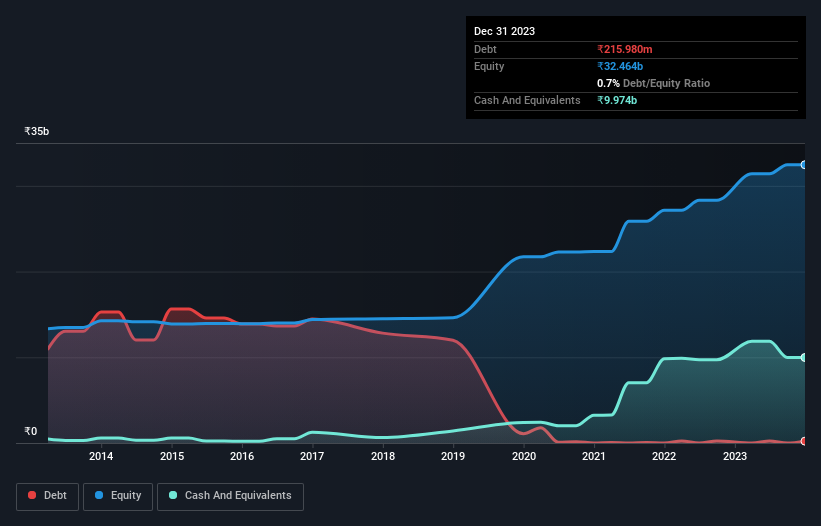Linde India (NSE:LINDEINDIA) Could Easily Take On More Debt

David Iben put it well when he said, 'Volatility is not a risk we care about. What we care about is avoiding the permanent loss of capital.' When we think about how risky a company is, we always like to look at its use of debt, since debt overload can lead to ruin. Importantly, Linde India Limited (NSE:LINDEINDIA) does carry debt. But the real question is whether this debt is making the company risky.
When Is Debt A Problem?
Generally speaking, debt only becomes a real problem when a company can't easily pay it off, either by raising capital or with its own cash flow. Part and parcel of capitalism is the process of 'creative destruction' where failed businesses are mercilessly liquidated by their bankers. However, a more frequent (but still costly) occurrence is where a company must issue shares at bargain-basement prices, permanently diluting shareholders, just to shore up its balance sheet. Of course, plenty of companies use debt to fund growth, without any negative consequences. When we examine debt levels, we first consider both cash and debt levels, together.
View our latest analysis for Linde India
What Is Linde India's Debt?
You can click the graphic below for the historical numbers, but it shows that as of September 2023 Linde India had ₹216.0m of debt, an increase on none, over one year. But on the other hand it also has ₹9.97b in cash, leading to a ₹9.76b net cash position.

A Look At Linde India's Liabilities
According to the last reported balance sheet, Linde India had liabilities of ₹9.38b due within 12 months, and liabilities of ₹3.13b due beyond 12 months. Offsetting these obligations, it had cash of ₹9.97b as well as receivables valued at ₹5.95b due within 12 months. So it actually has ₹3.41b more liquid assets than total liabilities.
Having regard to Linde India's size, it seems that its liquid assets are well balanced with its total liabilities. So while it's hard to imagine that the ₹475.8b company is struggling for cash, we still think it's worth monitoring its balance sheet. Simply put, the fact that Linde India has more cash than debt is arguably a good indication that it can manage its debt safely.
Also positive, Linde India grew its EBIT by 22% in the last year, and that should make it easier to pay down debt, going forward. There's no doubt that we learn most about debt from the balance sheet. But ultimately the future profitability of the business will decide if Linde India can strengthen its balance sheet over time. So if you're focused on the future you can check out this free report showing analyst profit forecasts.
But our final consideration is also important, because a company cannot pay debt with paper profits; it needs cold hard cash. Linde India may have net cash on the balance sheet, but it is still interesting to look at how well the business converts its earnings before interest and tax (EBIT) to free cash flow, because that will influence both its need for, and its capacity to manage debt. Over the most recent three years, Linde India recorded free cash flow worth 56% of its EBIT, which is around normal, given free cash flow excludes interest and tax. This cold hard cash means it can reduce its debt when it wants to.
Summing Up
While we empathize with investors who find debt concerning, you should keep in mind that Linde India has net cash of ₹9.76b, as well as more liquid assets than liabilities. And we liked the look of last year's 22% year-on-year EBIT growth. So we don't think Linde India's use of debt is risky. Above most other metrics, we think its important to track how fast earnings per share is growing, if at all. If you've also come to that realization, you're in luck, because today you can view this interactive graph of Linde India's earnings per share history for free.
At the end of the day, it's often better to focus on companies that are free from net debt. You can access our special list of such companies (all with a track record of profit growth). It's free.
New: AI Stock Screener & Alerts
Our new AI Stock Screener scans the market every day to uncover opportunities.
• Dividend Powerhouses (3%+ Yield)
• Undervalued Small Caps with Insider Buying
• High growth Tech and AI Companies
Or build your own from over 50 metrics.
Have feedback on this article? Concerned about the content? Get in touch with us directly. Alternatively, email editorial-team (at) simplywallst.com.
This article by Simply Wall St is general in nature. We provide commentary based on historical data and analyst forecasts only using an unbiased methodology and our articles are not intended to be financial advice. It does not constitute a recommendation to buy or sell any stock, and does not take account of your objectives, or your financial situation. We aim to bring you long-term focused analysis driven by fundamental data. Note that our analysis may not factor in the latest price-sensitive company announcements or qualitative material. Simply Wall St has no position in any stocks mentioned.
About NSEI:LINDEINDIA
Flawless balance sheet with high growth potential.
Market Insights
Community Narratives




